Birdfinding.info ⇒ Common and easy to find across most of its range, including cities and hotel gardens. On Jamaica, reliable sites include Rocklands Bird Sanctuary, Marshall’s Pen, Green Castle Estate, Hope Gardens, and Hardwar Gap. In the Dominican Republic, very common at many well visited sites, including the Rabo de Gato Trail and the National Botanical Garden in Santo Domingo. It can also be found without much difficulty in resort areas such as Punta Cana and La Romana.
Vervain Hummingbird
Mellisuga minima
Caribbean endemic found on Jamaica, Hispaniola, its satellite islands (Tortue, Gonâve, Île-á-Vache, Catalina, and Saona), and Mona Island. Has also been recorded as a vagrant on Puerto Rico.
Widespread and common in semi-open habitats including scrub, woodland edges, and settled areas.
Identification
Its tiny size and short bill are normally sufficient to identify it. Both sexes have green upperparts and largely white-to-grayish underparts.
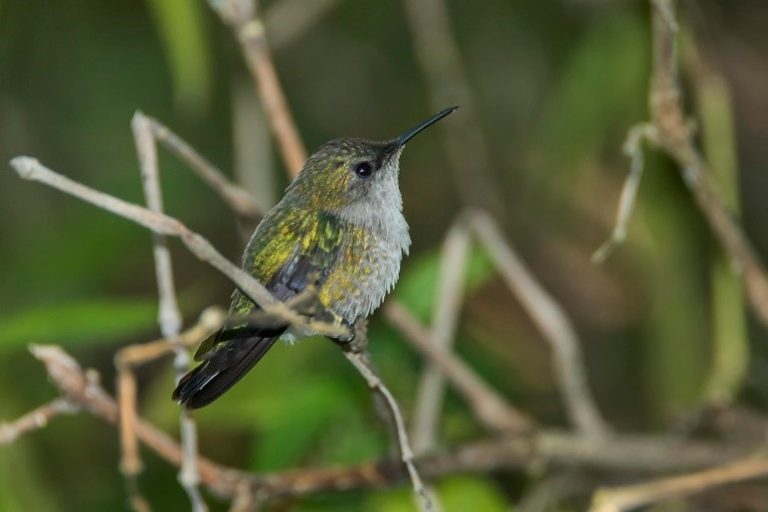
Vervain Hummingbird, male. (Dominican Republic; January 21, 2018.) © Pedro Genaro Rodríguez
Male has a partial green or gold vest, dotted throat, and a slightly notched, all-black tail. The vest and throat markings are variable—some individuals are mostly green or gold below, others are mostly whitish or gray.

Vervain Hummingbird, male showing green and gold vest. (Dominican Republic; February 18, 2009.) © Miguel A. Landestoy T.
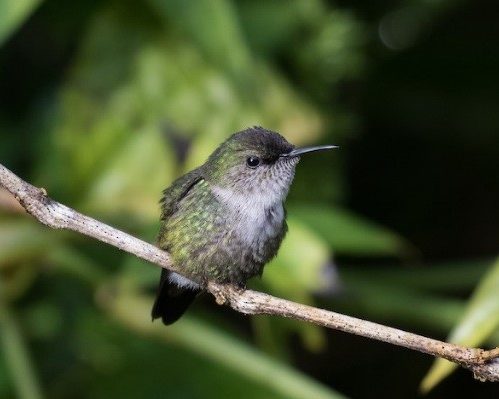
Vervain Hummingbird, male showing green and gold vest. (National Botanical Garden, Santo Domingo, Dominican Republic; January 17, 2018.) © Simon Best
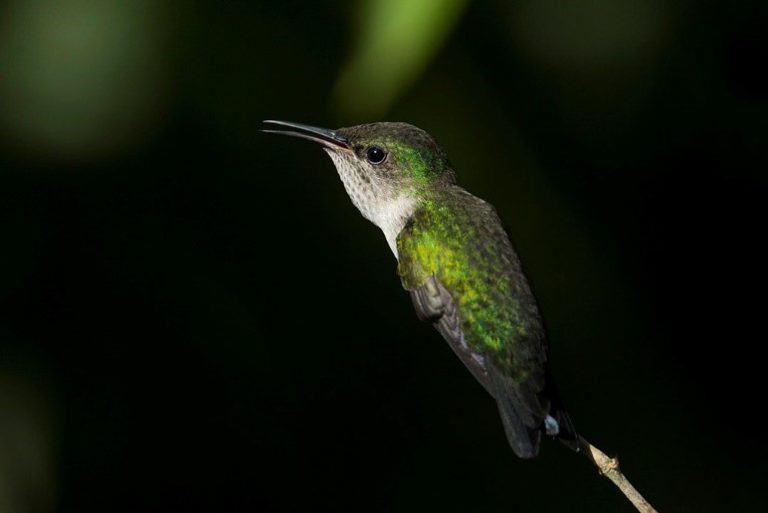
Vervain Hummingbird, male. (Dominican Republic; January 21, 2018.) © Pedro Genaro Rodríguez

Vervain Hummingbird, male showing a pronounced green vest. (Dominican Republic; May 8, 2010.) © Carlos de Soto Molinari
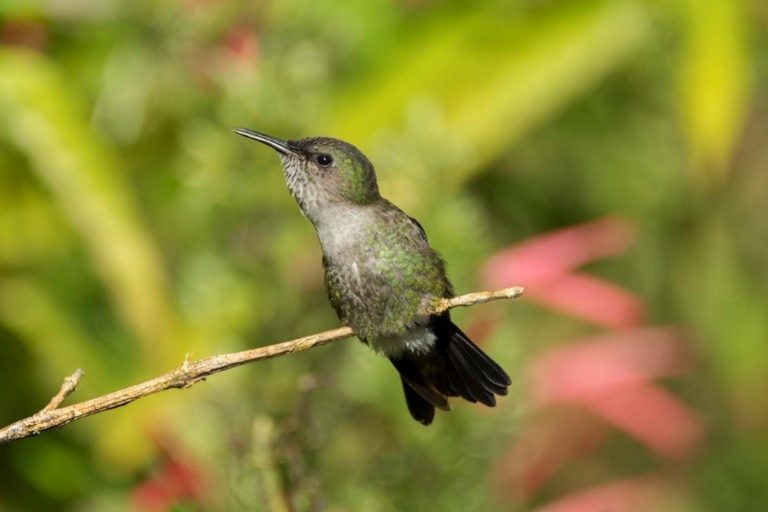
Vervain Hummingbird, male showing notched tail. (Dominican Republic; January 21, 2018.) © Pedro Genaro Rodríguez
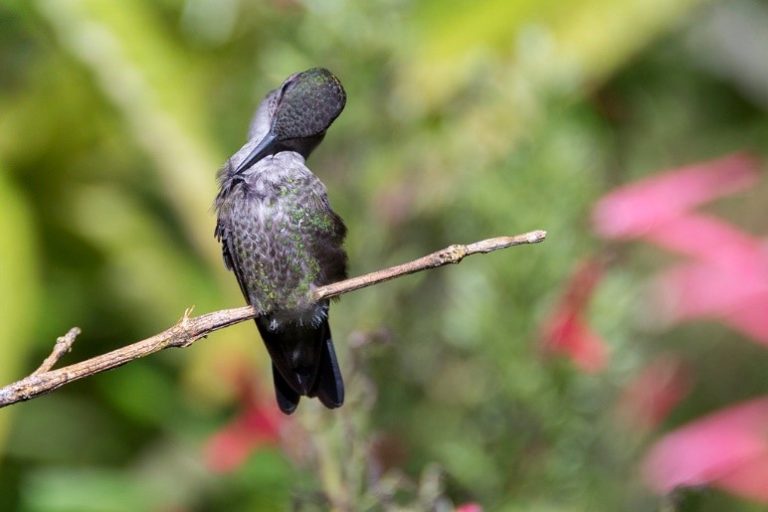
Vervain Hummingbird, male preening. (Dominican Republic; January 21, 2018.) © Pedro Genaro Rodríguez
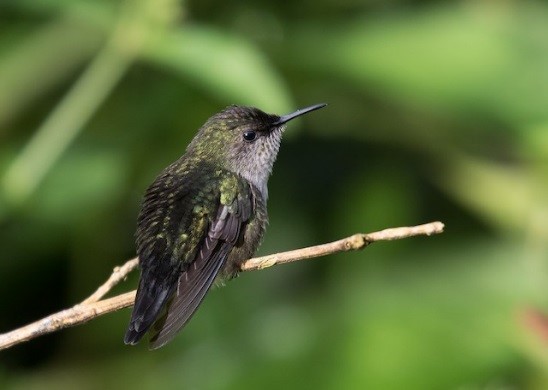
Vervain Hummingbird, male. (National Botanical Garden, Santo Domingo, Dominican Republic; January 17, 2018.) © Simon Best
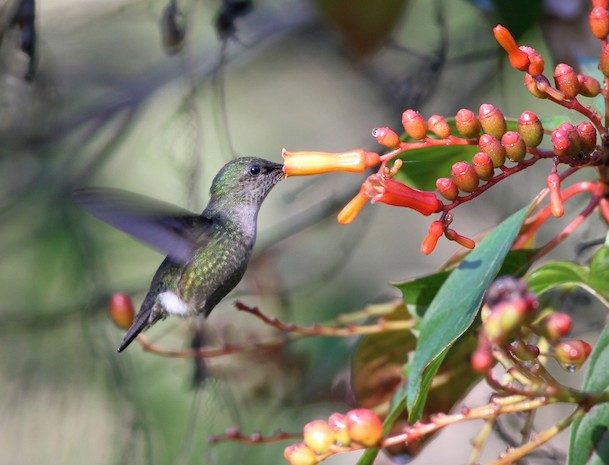
Vervain Hummingbird, male. (National Botanical Garden, Santo Domingo, Dominican Republic; March 17, 2012.) © Simon Best
Males sing year-round from prominent perches, usually an exposed twig at the top of a tree or bush.

Vervain Hummingbird, male as it is most often seen, as a speck on a prominent twig, emitting loud chirps. (Zanglais d’Aquin, Haiti; December 13, 2017.) © Richard Dunn
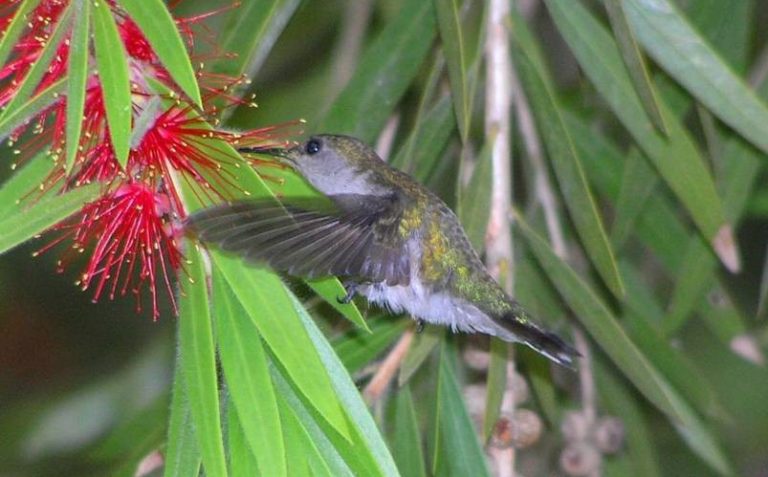
Vervain Hummingbird, female. (Mona, Jamaica; January 2007.) © Jan van den Boerck
Female is essentially unmarked below and has a slightly rounded black tail with white corners.
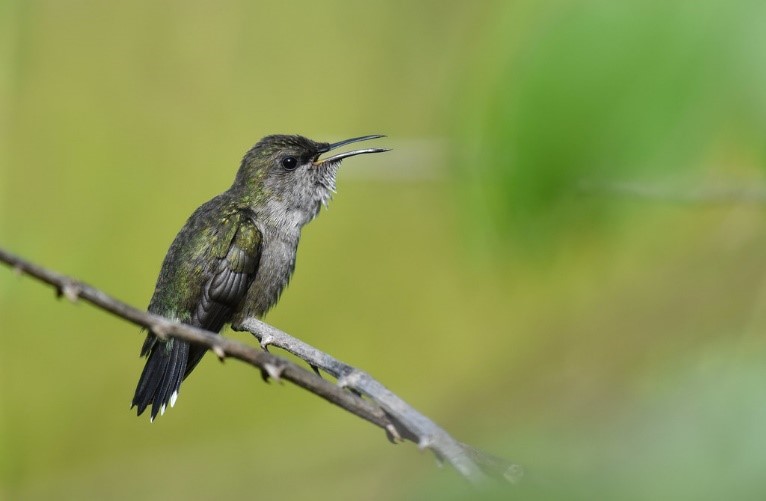
Vervain Hummingbird, female—note the small white corners on the tail. (Punta Cana, Dominican Republic; February13, 2018.) © Sadik Kassam
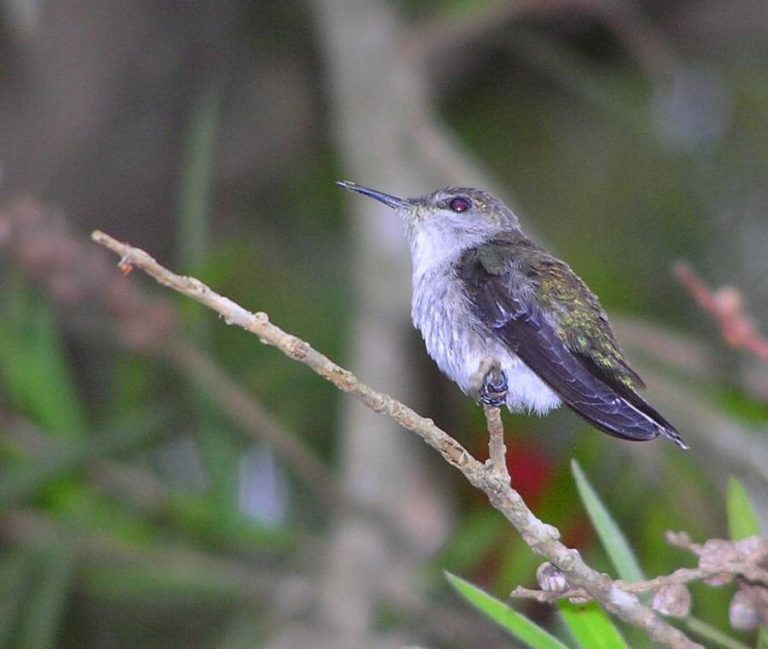
Vervain Hummingbird, female. (Mona, Jamaica; January 2007.) © Jan van den Boerck
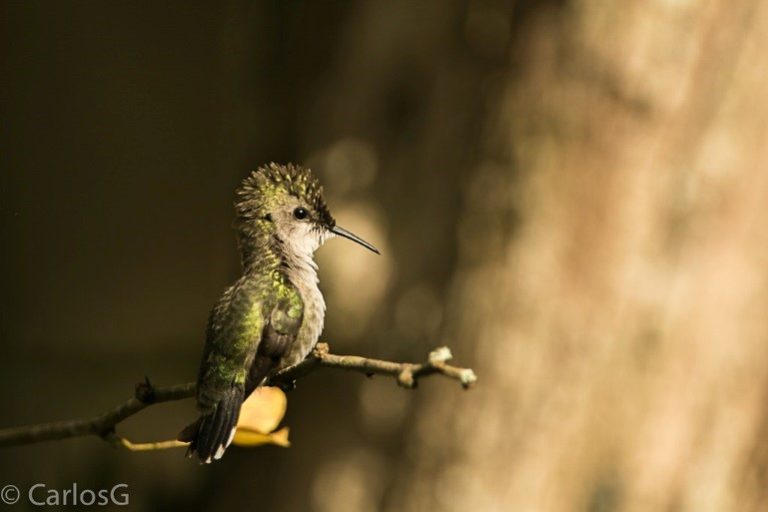
Vervain Hummingbird, female showing white corners on black tail. (National Botanical Garden, Santo Domingo, Dominican Republic; November 19, 2017.) © Carlos Gomez

Vervain Hummingbird, female showing white corners on rounded black tail. (Punta Cana Ecological Foundation, Dominican Republic; January 13, 2018.) © Jeremy Collison
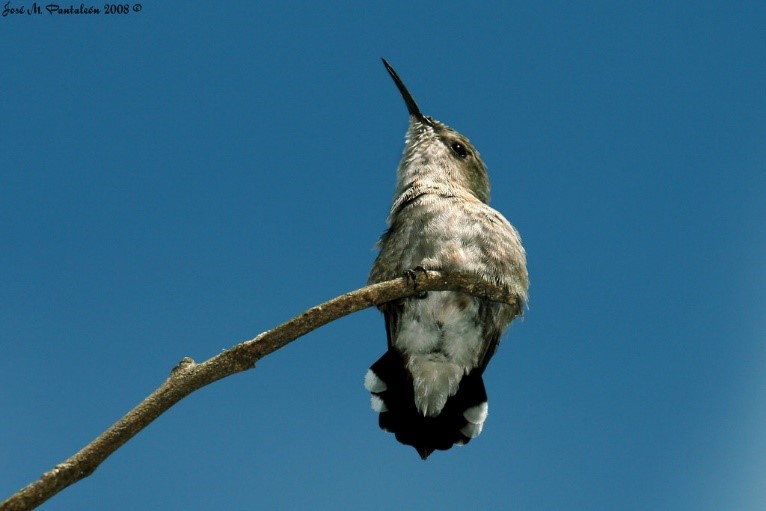
Vervain Hummingbird, female showing white corners on black tail. (San Francisco de Macoris, Dominican Republic; November 29, 2008.) © José M. Pantaleón
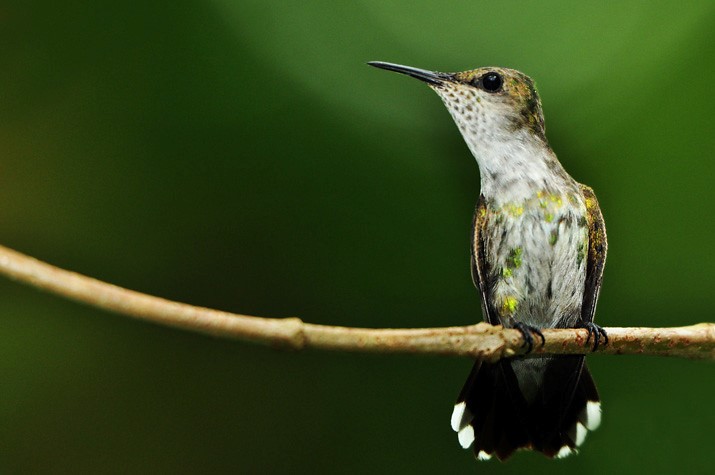
Vervain Hummingbird, female showing white corners on black tail and unusually prominent flecks of green and gold on the throat and breast. (Dominican Republic; October 4, 2010.) © Carlos de Soto Molinari
Cf. Hispaniolan Emerald. On Hispaniola, both sexes of Vervain could potentially be confused with female Hispaniolan Emerald. The emerald’s tail is longer, notched, and white-tipped, whereas Vervain has either a slightly notched, all-black tail (male) or a rounded, white-cornered tail (female). The emerald also shows a white post-ocular streak or spot.
Cf. Antillean Crested Hummingbird. On Puerto Rico, where Vervain has occurred, the very similar female Antillean Crested Hummingbird is only slightly larger, with a longer, broader, more rounded tail that is more extensively tipped with white, but is otherwise indistinguishable by sight.
Cf. Ruby-throated Hummingbird. A rare winter visitor to the West Indies, the female Ruby-throated Hummingbird is similar to Vervain, but larger with a rounded, broadly white-cornered tail and a white post-ocular spot.
Notes
Polytypic species consisting of two recognized subspecies: minima and vielloti.
Considered to be the world’s second-smallest bird, after its close relative, the Bee Hummingbird, though many other hummingbirds are approximately the same size. Vervain’s average length is approximately 6 cm, including the bill (10 to 11 mm), and average weight approximately 2.0 to 2.3 grams. (Clark 2009)
References
Clark, C.J. 2009. Vervain Hummingbird (Mellisuga minima), version 1.0. In Neotropical Birds Online (T.S. Schulenberg, ed.). Cornell Lab of Ornithology, Ithaca, N.Y. https://doi.org/10.2173/nb.verhum1.01.
eBird. 2018. eBird: An online database of bird distribution and abundance. Cornell Lab of Ornithology, Ithaca, N.Y. http://www.ebird.org. (Accessed November 3, 2018.)
Fogden, M., M. Taylor, and S.L. Williamson. 2014. Hummingbirds: A Life-size Guide to Every Species. HarperCollins, New York.
Haynes-Sutton, A., A. Downer, R. Sutton, and Y.-J. Rey-Millet. 2009. A Photographic Guide to the Birds of Jamaica. Princeton University Press, Princeton, N.J.
Latta, S., C. Rimmer, A. Keith, J. Wiley, H. Raffaele, K. McFarland, and E. Fernandez. 2006. Birds of the Dominican Republic and Haiti. Princeton University Press, Princeton, N.J.
Raffaele, H., J. Wiley, O. Garrido, A. Keith, and J. Raffaele. 1998. A Guide to the Birds of the West Indies. Princeton University Press, Princeton, N.J.
